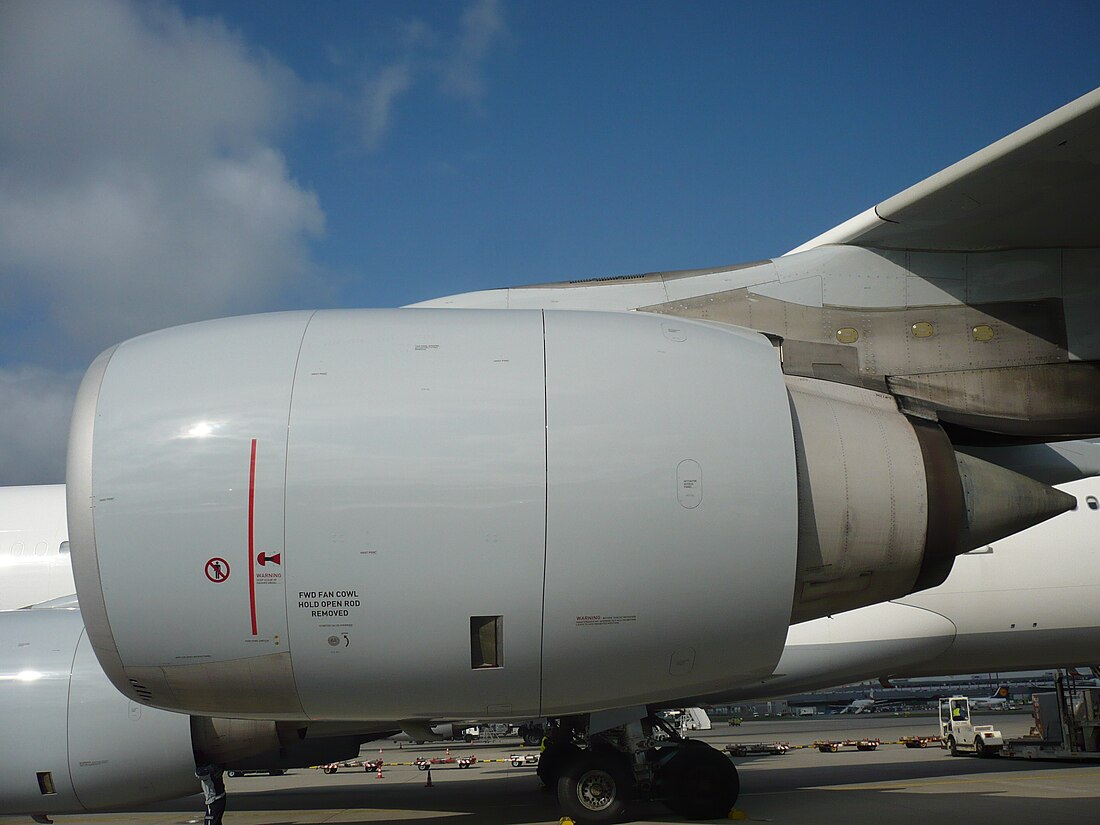Top Qs
Timeline
Chat
Perspective
Rolls-Royce Trent 500
1990s British turbofan aircraft engine From Wikipedia, the free encyclopedia
Remove ads
The Rolls-Royce Trent 500 is a high-bypass turbofan produced by Rolls-Royce to power the larger A340-500/600 variants. It was selected in June 1997,[1] first ran in May 1999,[2] first flew in June 2000, and achieved certification on 15 December 2000.[3] It entered service in July 2002 and 524 engines were delivered on-wing until the A340 production ended in 2012.
Keeping the three spool architecture of the Trent family, it has the Trent 700's 2.47 m (97.5 in) fan and a Trent 800 core scaled down.[4] It produces up to 275 kN (62,000 lbf) of thrust at take-off and has a bypass ratio up to 8.5:1 in cruise.[3]
Remove ads
Development
Summarize
Perspective
In 1995, Airbus began considering an engine for two new long-range derivatives of its four-engined A340, the A340-500/600. The existing A340-200/300 was powered by CFM International CFM56 engines. However, the CFM56 was at the limit of its development capability, and would be unable to power the new A340-500/-600. In April 1996, Airbus signed an agreement with GE Aviation to develop a suitable engine, but decided not to proceed when GE demanded an exclusivity deal on the A340.[5][1]
Certification was applied for on 9 February 1998,[3] and first ran in May 1999.[2] By July 1999, Rolls-Royce had secured $5 billion worth of Trent 500 orders.[6] Flight testing began in late June 2000 on a modified A340 testbed. By July 2000, the test program had amassed 1,750h and 2,00 cycles, and aimed for 15,000h and 4,000-5,000 cycles before introduction.[4] It achieved certification on 15 December 2000.[3]
The Trent 500 entered service on the A340-600 with Virgin Atlantic in July 2002 and on the ultra-long range A340-500 with Emirates in December 2003. Air Canada had been expected to be the launch customer for the A340-500 in May 2003, but just before this on 1 April 2003 the airline filed for bankruptcy protection which resulted in delivery of its two A340-500s being delayed. This allowed Emirates to be the first airline to operate the type.[citation needed] After production of the Airbus A340 ended in 2011, a total of 131 A340-500/-600 have been delivered with 524 Trent 500 engines altogether; Lufthansa is the largest operator, with 24 delivered A340-600.[7]
Remove ads
Design
Summarize
Perspective
The Trent 500 is a high bypass turbofan with three spools: the fan is powered by a 5 stage Low Pressure turbine (nominal speed: 3,900 RPM), the Intermediate pressure spool has an 8-stage axial compressor (9,100 RPM) and the High Pressure spool has an 6-stage axial compressor (13,300 RPM), both driven by a single turbine stage. It has an annular combustor and is equipped with an Electronic Engine Control System.[3]
It is flat rated at ISA + 15°C for 248.1–275.3 kN (55,800–61,900 lbf) net thrust at take-off and has an 8.5:1 bypass ratio in cruise.[3]
The Trent 500 is essentially a scaled Trent 800, with a 2.47 m (97 in) fan with 26 unswept blades like the Trent 700. The IP and HP compressors and scaled-down by 20% from the Trent 892, while the turbines are scaled-down by 90% and are made of single crystal CMSX-4 alloy with thermal barrier coatings. Fuel burn is 1% lower because of 3D aerodynamics. It was tested up to 68,000 lbf (300 kN) to establish limits.[4]
The Trent 500 powers the A340-500/600.[8] It was certificated at 60,000 lbf (270 kN) thrust, but derated to 53,000 lbf (240 kN) as the Trent 553 to power the A340-500, and to 56,000 lbf (250 kN) as the Trent 556 for the A340-600 and A340-500HGW. However, a 60,000 lbf (270 kN) version is installed in the A340-600HGW (High Gross Weight), a higher-performance version of the A340-600. The Trent 500 has the same wide chord fan as the Trent 700, together with a core scaled from the Trent 800.
Remove ads
Applications
Specifications

Data from EASA[3]
General characteristics
- Type: Three-shaft high bypass turbofan
- Length: 468.9 cm (184.6 in)
- Diameter: 247 cm (97 in)[9]
- Dry weight: 4,990 kg (11,000 lb)
Components
- Compressor: Single-stage fan, eight-stage intermediate pressure compressor, six-stage high pressure compressor
- Combustors: Tiled annular with 20 fuel injectors
- Turbine: Single-stage high pressure turbine, single-stage intermediate pressure turbine, five-stage low pressure turbine
Performance
- Maximum thrust: 248.1–275.3 kN (55,780–61,902 lbf)
- Overall pressure ratio: 35:1[10]
- Bypass ratio: 7.5–7.6[9] to 8.5:1 in cruise[3]
- Air mass flow: 860–880 kg/s (1,900–1,900 lb/s)[9]
- Specific fuel consumption: 55.3 g/N/h (0.542 lb/lbf/h) at cruise[11]
- Thrust-to-weight ratio: 5.07–5.63
Type designators
Remove ads
See also
Related development
Comparable engines
Related lists
References
External links
Wikiwand - on
Seamless Wikipedia browsing. On steroids.
Remove ads

